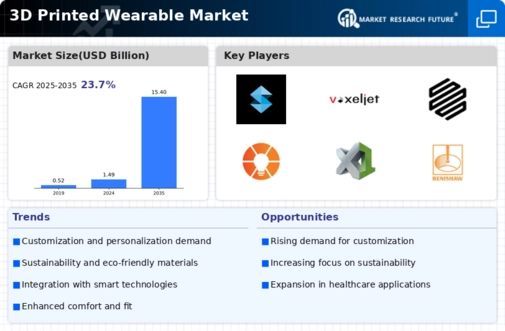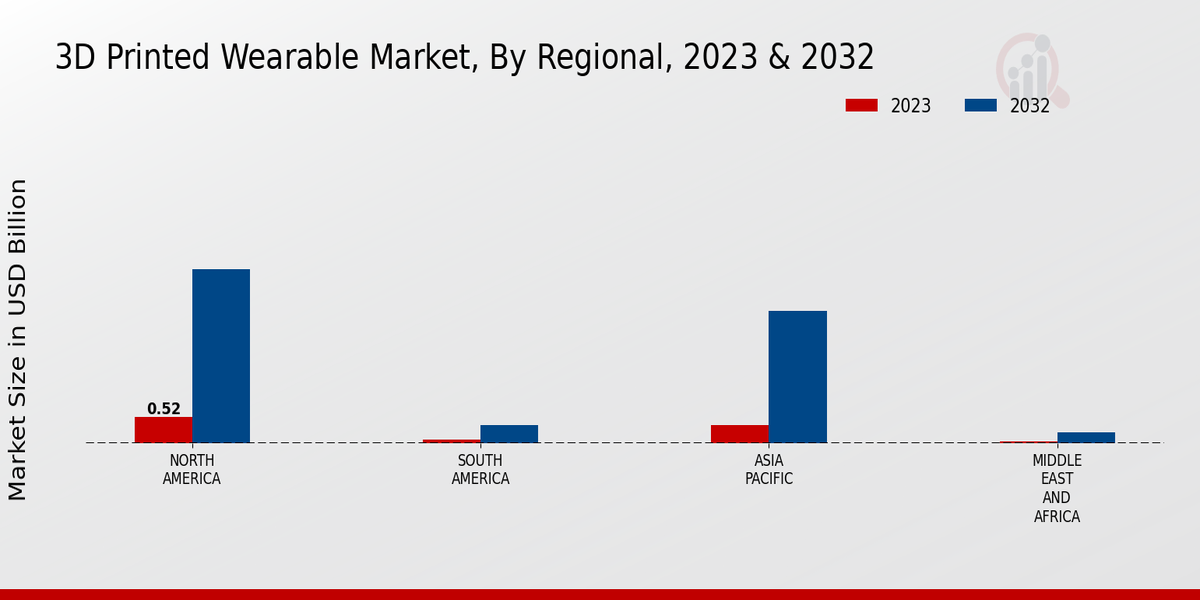Rising Health Awareness
Increasing health consciousness among consumers is driving the Global 3D Printed Wearable Market Industry. Wearable devices that monitor health metrics such as heart rate, sleep patterns, and physical activity are gaining popularity. This trend is particularly evident in the fitness and healthcare sectors, where personalized wearables are being developed to cater to individual health needs. The market's growth is expected to accelerate, with projections indicating a rise to 15.4 USD Billion by 2035. This shift towards proactive health management suggests a significant opportunity for 3D printed wearables that provide tailored health insights.
Market Growth Projections
The Global 3D Printed Wearable Market Industry is poised for substantial growth, with projections indicating a rise from 1.49 USD Billion in 2024 to 15.4 USD Billion by 2035. This trajectory suggests a robust CAGR of 23.69% from 2025 to 2035, driven by various factors including technological advancements, rising health awareness, and increasing demand for customization. The market's expansion reflects a broader trend towards innovative and personalized wearable solutions, positioning it as a dynamic sector within the broader technology landscape.
Sustainability Initiatives
Sustainability is becoming a pivotal factor in the Global 3D Printed Wearable Market Industry. As environmental concerns grow, manufacturers are increasingly adopting eco-friendly practices in the production of wearable devices. 3D printing allows for reduced material waste and the use of sustainable materials, aligning with consumer preferences for environmentally responsible products. This shift not only meets regulatory requirements but also enhances brand reputation. The integration of sustainable practices is expected to play a crucial role in market expansion, as consumers are more inclined to support brands that prioritize sustainability.
Technological Advancements
The Global 3D Printed Wearable Market Industry is experiencing rapid growth due to continuous technological advancements in 3D printing techniques. Innovations such as improved materials, faster printing speeds, and enhanced design capabilities are enabling manufacturers to create more complex and functional wearable devices. For instance, the introduction of biocompatible materials allows for the production of wearable health monitors that can be comfortably worn on the skin. As a result, the market is projected to reach 1.49 USD Billion in 2024, reflecting a growing demand for customized and innovative wearable solutions.
Customization and Personalization
The demand for customization and personalization in wearable technology is a key driver for the Global 3D Printed Wearable Market Industry. Consumers increasingly seek products that reflect their individual preferences and lifestyles. 3D printing technology allows for the creation of bespoke wearable devices that can be tailored to fit specific body shapes and personal styles. This capability not only enhances user experience but also fosters brand loyalty. As the market evolves, the ability to offer unique, personalized wearables is likely to become a competitive advantage, contributing to the anticipated CAGR of 23.69% from 2025 to 2035.
Integration of IoT and Smart Technologies
The integration of Internet of Things (IoT) and smart technologies is significantly influencing the Global 3D Printed Wearable Market Industry. Wearables that connect to smartphones and other devices provide users with real-time data and insights, enhancing functionality and user engagement. This trend is particularly relevant in sectors such as healthcare, where connected wearables can transmit vital health information to medical professionals. As the market continues to evolve, the synergy between 3D printing and smart technologies is likely to create innovative solutions that cater to diverse consumer needs.




















